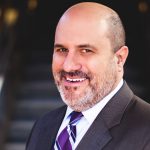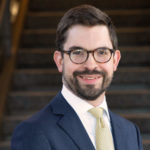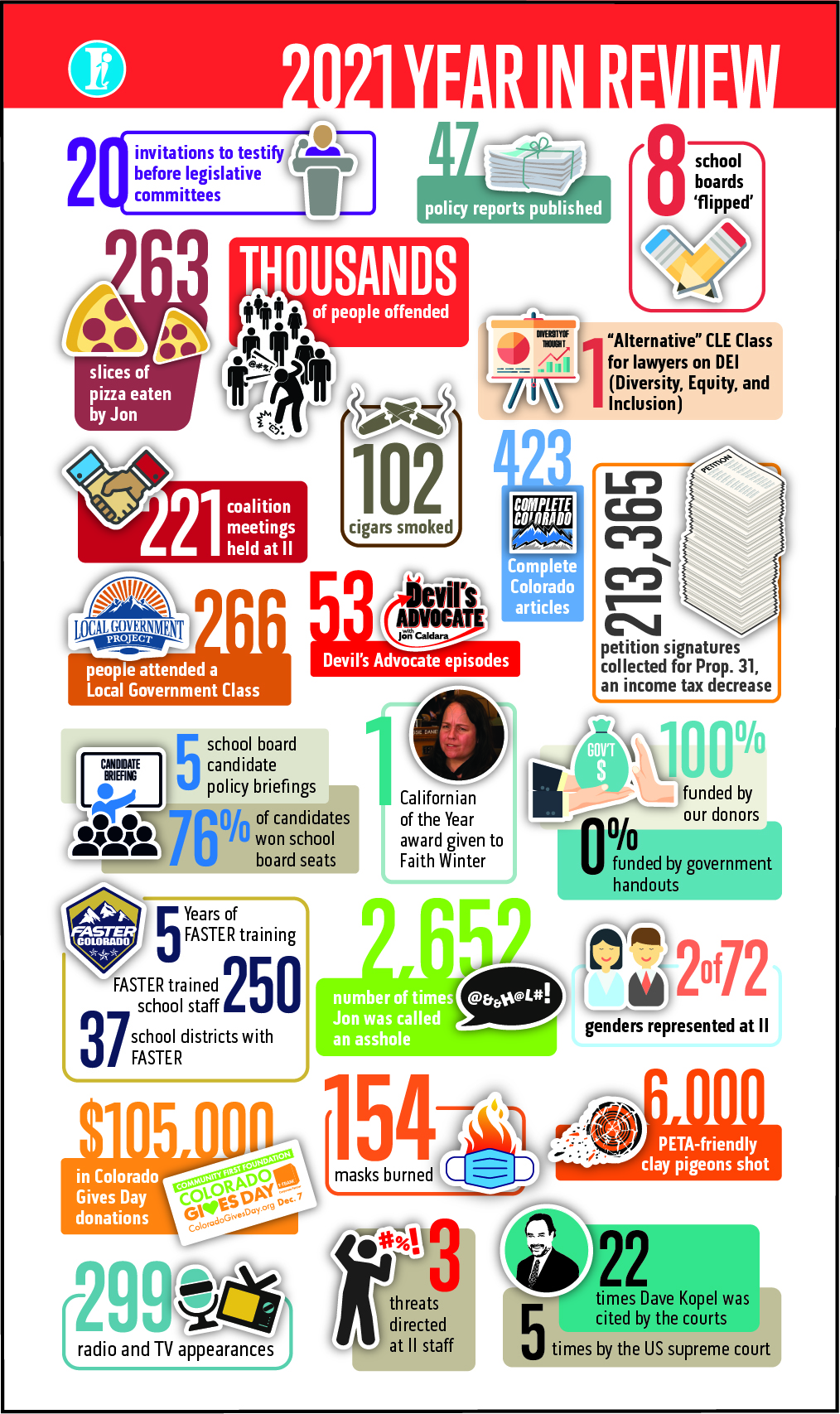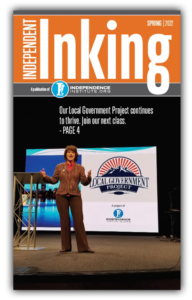INDEPENDENT INKING
This fall’s election should be a huge victory for Colorado.
While political fortunes can change in a moment and November is a long way away, as it stands Colorado Republicans should take back the State Senate and I even think the House. I also would say the Treasurer and Secretary of State offices will be in play.
I will go so far as to say even our state’s progressive overlord, Jared Polis, could be in danger of losing re-election. Keep in mind I am in the minority here, but let me share my thinking.
From any current standpoint, there is no way Jared can lose. If need be, he can just write himself another campaign check for $25 million. There is nobody I see running on the other team that can do that.
Jared is wildly popular. The press would take a bullet for him. He is a shoo-in, except for one tiny but snowballing issue.
Colorado’s government is drowning in money. So much so that the Legislature (and wrap your head around this) can’t spend it all. Good thing that, with your help, Independence Institute has a permanent income tax cut on the ballot!
Where did all this money come from? Well, it came out of thin air. It’s Monopoly money from Washington.
And the very same reason why Colorado’s state purse is bursting at the seams is the same reason why Jared Polis could lose reelection.
It’s called inflation.
When any central bank prints money out of thin air, it eventually leads to inflation.
Since Barack Obama was sworn into office, the Federal Reserve has grown our money supply by nearly 200%. Since COVID hit, it’s gone up by around 40%. Over time, the prices we pay rise to match.
Congress can’t stop spending (birds gotta fly, fish gotta swim) and the Federal Reserve, fearing a recession, will not do what’s necessary to stop it. Inflation will continue to run hot.
While maybe not likely, it is not out of the realm of possibility that we have double-digit inflation by the time the fall elections roll around.
No amount of lip service from our new “affordability” governor will be able to make up for all the inflationary actions he and his administration have taken.
Think Freedom,
Jon
Boulder’s Anti-sprawl Planning Helped the Marshall Fire Destroy Hundreds of Homes
BY RANDAL O’TOOLE
Just before New Year’s Day, the Marshall Fire ripped through Boulder County, killing two people and burning more than 1,000 homes and other buildings, most of them in Superior and Louisville.

RANDAL O’TOOLE
Transportation Policy Center Director
No one knows exactly what caused the fire, but one thing is certain: the effects of the fire were made much worse by Boulder County’s open space programs and dense zoning in the cities.
Forest Service research has shown that the best way to protect people’s homes from wildfire is to make the homes and surrounding property as fireproof as possible. The roofs should be made of non-flammable materials. Walls can be made of wood, but no vegetation, other than perhaps grass, should be close to the walls. Fire specialists call this fire-wise or defensible space.
An important part of defensible space is that homes should be located at least 100 to 140 feet apart from one another. Otherwise, if one home catches fire, the radiant heat from that fire will ignite its neighbors. This means that anti-sprawl, density mandates favored by urban planners are setting people up to have their homes burn in wildfires.
In the interior West, no place has enacted more stringent anti-sprawl policies than Boulder County. Almost a third of the land in the county has been made into open spaces, either through purchases or conservation easements. Most of the rest of the county outside of incorporated cities is zoned for 35-acre minimum lot sizes. The cities themselves zoned land for dense development, too dense to allow 100 feet between homes.
The Marshall Fire was first reported at 11 a.m. on December 30 near the intersection of State Highway 93 and Marshall Road. It took a full hour to burn across three miles of grasslands before it reached the town of Superior, where hundreds of homes were crammed in as little as ten feet apart from one another. The fire quickly burned all these buildings to the ground while it spared many houses on larger lots, provided those homes didn’t have a lot of flammable vegetation around them.
To guard against future wildfires, Boulder County needs to put a buffer around all existing cities consisting of homes on one- to two-acre lots that are maintained in a defensible condition. This may mean selling some open space or undoing some conservation easements. If the county refuses to do that, I urge everyone who lives on a small lot in the county to have excellent fire insurance or, better yet, move out before the next fire season. If you aren’t yet convinced, please read my four-page policy brief reviewing the Marshall Fire and how it was affected by Boulder County plans.
Applying the Principles of Free-Market Economics
BY BEN MURREY
In the fall edition of Independent Inking, the Fiscal Policy Center announced the release of a study on the economic consequences of Polis’ COVID-19 mandates.
In it, we highlighted the impact of lockdowns on small businesses in Colorado, but the study also uncovered weaknesses in Colorado’s workforce. This winter, the Center published two concurrent studies on the skilled labor shortage in Colorado and how to address it from a free-market perspective.
Our research paper, Unequal Opportunities, Unequal Outcomes: The COVID-19 Recession in Colorado, found that Colorado has a high number of workers in vulnerable, low-skilled jobs who lost employment during the pandemic. Today, employment in the industries that suffered most during the pandemic—hospitality and food services—still has not recovered to pre-pandemic levels. Meanwhile, businesses in industries such as construction cannot seem to find enough skilled workers to fill open positions.
This prompted our investigation into the nature and extent of the skills gap in Colorado’s workforce in a study we published in December, The Colorado Skills Gap: Underlying Causes. Using employment data, we ran an economic shift-share analysis to identify industries in which skills gaps persist.
The Fiscal Policy Center conducted research into existing workforce policies and career and technical education in the state. To better understand the problem and possible solutions, the Center also engaged with dozens of stakeholders from industry, government, and other think tanks across the nation. This culminated in a policy paper published in January, Addressing the Skills Gap: A Market-Based Approach for Colorado.
The paper provides an overview of how the federal government and states have been involved in promoting vocational and workforce training for over a century and have gradually but extensively expanded the reach of its policies over time. It explains why, despite government intervention, Colorado still suffers from a severe skilled labor shortage in many industries.
Citing Austrian economists, including F.A. Hayek and Carl Menger, the paper applies principles of free-market economics to the skilled labor problem and related public policies. It concludes that because central planners will always fall short of the knowledge necessary to engineer the labor market properly, all public policy intended to address the labor needs of the economy must rely instead on free-market principles. To guide policymakers in crafting future legislation to address the skills gap, it provides three guideposts, specifically:
Market forces rather than central planning must drive solutions.
Any public funding must be tied to no more than two simple, specific, and easily measurable outcomes.
Government programs and incentives cannot be so overly cumbersome or complex as to prevent widespread use by industry and/or laborers.
In addition, the paper offers one possible policy solution which follows their guidelines and could help close the skilled labor gap in Colorado: an opportunity scholarship tax credit to incentivize the training of skilled laborers.
In February, I had the opportunity to testify on workforce development legislation in the Senate Education Committee. I presented findings from our studies and, in follow-up questions, outlined for legislators the three principles of market-driven workforce policy.
Independence Institute’s Education Policy Center has contributed to vocational education initiatives in Colorado high schools. With the latest work of the Fiscal Policy Center, Independence Institute has extended its reach into workforce development and vocational training beyond K-12.
California and Colorado’s Unholy Regulatory Alliance
BY JAKE FOGLEMAN
Here at the Independence Institute, we’ve known for years now that California is the source of many bad ideas that end up winding their way into Colorado. Zero Emission Vehicle (ZEV) mandates are just the latest case study.

JAKE FOGLEMAN
Policy Analyst, Center for Energy and Environment
As it currently stands, California is the only state in the country allowed to establish their own vehicle emissions regulations, while other states are left either to adopt the California Air Resource Board (CARB) program or those established by federal officials.
Guess which Colorado chose?
Thanks to a 2019 Executive Order from Governor Polis, and subsequent rulemaking from the unelected members of the Air Quality Control Commission, the Colorado auto industry and local consumers are subject to the whims of California bureaucrats, whether they like it or not.
As of January 2, 2022, automakers must now make an increasing minimum percentage of ZEV sales each year as part of their light-duty fleet (8,500 pounds GVWR). Should they fail to meet the quotas, automakers will be required to buy credits from others that have banked them.
The policy stands to increase costs on auto dealers and consumers alike. Inventories must be shifted to accommodate the rules, while consumers interested in conventional vehicles will see their options diminish at a time when new vehicle inventory is already down 58% year over year.
But the “Californication” of Colorado’s vehicle rules doesn’t appear to be stopping there.
In 2020, California Governor Gavin Newsom signed an executive order banning the sale of new gas-powered cars and trucks after 2035. The order was then kicked to the CARB to formalize the rules in order to make Newsom’s decree a reality, consumer input be damned.
Colorado Energy Office Executive Director Will Toor has already said that Colorado officials are collaborating in that process, meaning the gas vehicle bans could be on their way here as well.
The regulations are simply a solution in search of a problem. Electric vehicle take-up is already happening organically among freely choosing consumers who want them. Mandates are wholly unnecessary and stand only to burden those who either can’t afford their premium price tag, or whose lifestyle cannot be accommodated by the limitations an electric vehicle brings.
Amidst 40-year-high inflation and greatly disrupted supply chains, executive decrees and regulations handed down from opaque bureaucracies are the last thing Colorado auto producers and consumers need.
You can trust the Independence Institute to stand watchful of the state’s regulators and continue to support Colorado energy consumers.
A Firearms Textbook for Everyone
BY DAVE KOPEL
Ever since the Independence Institute was founded in 1985, our effectiveness in the battle of ideas has been bemoaned by our critics and celebrated by our friends.
One reason for our success is giving our scholars the opportunity to focus on projects that produce the greatest effects in the long run. Too often in the world of public affairs, well-meaning organizations get trapped in the short-term news cycle. So I am very grateful that at the Independence Institute, I had the flexibility to spend most of 2021 writing two law school textbooks. Textbooks aren’t glamorous, but they can change the world.
One of those textbooks is Firearms Law and the Second Amendment: Regulation, Rights, and Policy, coauthored with four other law professors. My inspiration for the textbook might surprise you: Ruth Bader Ginsburg.
When she was a law professor at Rutgers, Ginsburg wrote a textbook, Constitutional Aspects of Sex Discrimination. What law students learn depends on what professors can teach, and teaching depends on what textbooks exist. Although some professors do collect or write their own materials for class, most of what gets taught in law school is from textbooks. Only if a textbook on women’s rights existed could women’s rights be broadly studied in law school.
By 1971, there were professors who sympathized with women’s rights but were far from expert on the subject. They could teach it only if someone else wrote a textbook. They had neither the time nor inclination to determine which cases and materials were most important, collect and edit them, and then organize them into an orderly narrative. So Ginsburg did it all for them. She also provided her own analysis.
Now, the same process is happening for the Second Amendment. Since 2012, Firearms Law has been spurring the creation of Second Amendment classes at law schools; every year more law students learn how to incorporate the right to keep and bear arms into their legal practice. Unlike in past generations, the new generation of lawyers includes members who are already well-educated about the right to keep and bear arms and gun control laws.
The success of Firearms Law and the Second Amendment has spurred two other publishers of law school textbooks to produce their own entries into what has become the growing field of Second Amendment education.
Firearms Law was written for more than just the law school audience. The style is accessible to the general intelligent reader, and the textbook is also a treatise of arms law and history, from ancient times to the present. As such, it has been useful to the courts. Judge Brett Kavanaugh, when he served on the D.C. Circuit Court of Appeals, cited the textbook. So did Judge Thomas Hardiman of the Third Circuit; he was the runner-up for the Supreme Court nomination that eventually went to Judge Kavanaugh. The Illinois Supreme Court has cited the textbook twice.
Firearms Law is neither small nor inexpensive. It runs 2,243 pages and costs $300. However, some of the book is available for free. The printed book is 16 chapters, and those are supplemented by seven online chapters, which are available at: firearmregulation.org.
Also free online is chapter 3 from the printed textbook, on colonial America. Did you know that in the English-speaking world, the first written guarantees of the right to arms were the colonial charters of Virginia in 1606 and New England in 1620? Neither did anyone else until I found out and put the history into Firearms Law. Even if you don’t buy the book, thank you for your donations to the Second Amendment Project at the Independence Institute. You helped make this book possible.
How Did Colorado’s Proposed Social Studies Standards Make a Left Turn?
BY PAMELA BENIGNO
In 2019, when public anger was mounted against drastic reforms to both K-12 sex education and vaccination laws, House Bill 19-1192 quietly passed through the Colorado legislature and was signed by the governor.
The law mandates teaching elementary and secondary students about the history, culture, and social contributions of American Indians, Latinos, African Americans, and Asian Americans; lesbian, gay, bisexual, and transgender individuals within these minority groups; the intersectionality of significant social and cultural features within these communities; and the contributions and persecution of religious minorities.
In addition, HB 19-1192 created a governor-appointed commission tasked with making recommendations for revisions to the state’s PK-12 history and civics academic standards. Handing over even more control over how history and civics are taught, the commission must develop and promote educational programs for public schools and participate in local school district civics standards community forums. The makeup of this unelected government body is spelled out in statute and mirrors the “groups” to which the law refers. If the governor would allow me to do so, I would be happy to assemble a commission that includes the same “groups,” but with individuals from a different political bent than he chose.
Other recent legislation also requires revisions to the social studies standards. Social studies include geography, economics, history, civics, and financial literacy. The social studies standards review committee, primarily made up of educators, combined legislative requirements and the 1192 Commission’s recommendations with their own revisions and created a 145-page document with the recommended revisions proposed to the elected State Board of Education.
It only took reading a few pages into the 145-page document to realize how the standards had been hijacked by the progressive left. You would think our country was founded for the purpose of oppressing marginalized groups rather than for freedom and opportunity.
Aspects of critical race theory are recognizable throughout the standards. For example, with an emphasis on groups rather than on individuals, it is suggested for teachers to ask first-grade children about the differences and similarities of African American, Latino, Asian American, Indigenous Peoples, LGBTQ, and religious minority cultures. And in second grade, students should understand how these groups work through conflict and promote social change.
Fortunately, before standards are adopted in Colorado, there is a formal process for public comment. I immediately alerted citizen education groups and individual activists about the proposed standards and explained how to participate in the public comment process. They were moved to action. I hired a high school social studies teacher to do an analysis of the standards based on historical accuracy and traditional content.
To notify the public about the proposed standards, we published our six-page comment letter on CompleteColorado.com. I asked the National Association of Scholars (NAS) for their assistance, and they published their excellent insights while also endorsing ours. In order to help spread the message to others, social studies teacher Kyle Walpole and I joined Jon Caldara on his PBS Devil’s Advocate show to discuss the issue. (The show is posted on our YouTube Channel, IITV.) I also made several guest appearances on popular radio shows.
We won’t know the results until sometime after June because the extensive number of comments delayed the process. The Colorado Department of Education received over 950 emails and letters and more than 16,600 individual comments on the standards through their online system. I am sure that a record number of people from the center-right made their voices heard. Now it is up to the Democrat-led State Board of Education to decide the final fate of the Colorado Academic Social Studies Standards.






